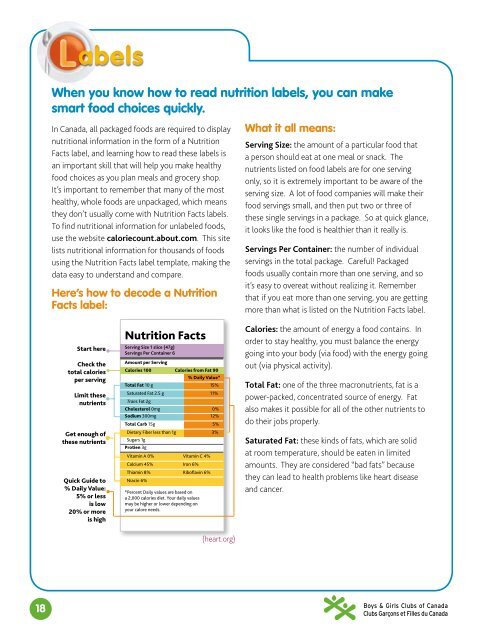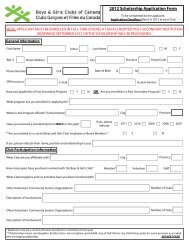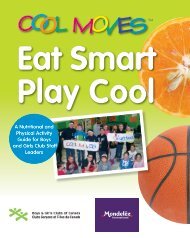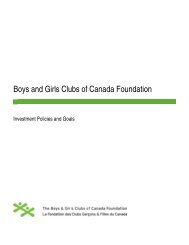Download - Boys and Girls Clubs of Canada
Download - Boys and Girls Clubs of Canada
Download - Boys and Girls Clubs of Canada
Create successful ePaper yourself
Turn your PDF publications into a flip-book with our unique Google optimized e-Paper software.
LabelsWhen you know how to read nutrition labels, you can makesmart food choices quickly.In <strong>Canada</strong>, all packaged foods are required to displaynutritional information in the form <strong>of</strong> a NutritionFacts label, <strong>and</strong> learning how to read these labels isan important skill that will help you make healthyfood choices as you plan meals <strong>and</strong> grocery shop.It’s important to remember that many <strong>of</strong> the mosthealthy, whole foods are unpackaged, which meansthey don’t usually come with Nutrition Facts labels.To find nutritional information for unlabeled foods,use the website caloriecount.about.com. This sitelists nutritional information for thous<strong>and</strong>s <strong>of</strong> foodsusing the Nutrition Facts label template, making thedata easy to underst<strong>and</strong> <strong>and</strong> compare.Here’s how to decode a NutritionFacts label:What it all means:Serving Size: the amount <strong>of</strong> a particular food thata person should eat at one meal or snack. Thenutrients listed on food labels are for one servingonly, so it is extremely important to be aware <strong>of</strong> theserving size. A lot <strong>of</strong> food companies will make theirfood servings small, <strong>and</strong> then put two or three <strong>of</strong>these single servings in a package. So at quick glance,it looks like the food is healthier than it really is.Servings Per Container: the number <strong>of</strong> individualservings in the total package. Careful! Packagedfoods usually contain more than one serving, <strong>and</strong> soit’s easy to overeat without realizing it. Rememberthat if you eat more than one serving, you are gettingmore than what is listed on the Nutrition Facts label.Start hereCheck thetotal caloriesper servingLimit thesenutrientsGet enough <strong>of</strong>these nutrientsQuick Guide to% Daily Value:5% or lessis low20% or moreis highNutrition FactsServing Size 1 slice (47g)Servings Per Container 6Amount per ServingCalories 100 Calories from Fat 90% Daily Value*Total Fat 10 g 15%Saturated Fat 2.5 g 11%Trans Fat 2gCholesterol 0mg 0%Sodium 300mg 12%Total Carb 15g 5%Dietary Fiber less than 1g 3%Sugars 1gProtien 3gVitamin A 0% Vitamin C 4%Calcium 45% Iron 6%Thiamin 8% Rib<strong>of</strong>lavin 6%Niacin 6%*Percent Daily values are based ona 2,000 calories diet. Your daily valuesmay be higher or lower depending onyour calore needs.(heart.org)Calories: the amount <strong>of</strong> energyNutritiona food contains. InNutrition Factsorder Serving to Size stay 1 slice(47g) healthy, you must balance the energyServings Per Container 6goingAmountintoper servingyour body (via food) with the energy goingout (via physical activity).Total Fat: one <strong>of</strong> the three macronutrients, fat is apower-packed, concentrated source <strong>of</strong> energy. Fatalso makes it possible for all <strong>of</strong> the other nutrients todo their jobs properly.Saturated Fat: these kinds <strong>of</strong> fats, which are solidat room temperature, should be eaten in limitedamounts. They are considered “bad fats” becausethey can lead to health problems like heart disease<strong>and</strong> cancer.18


